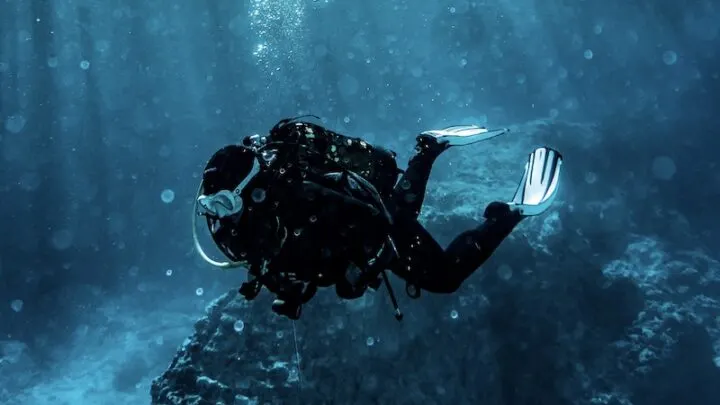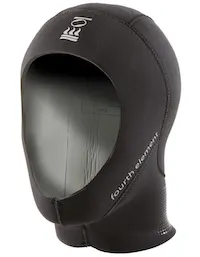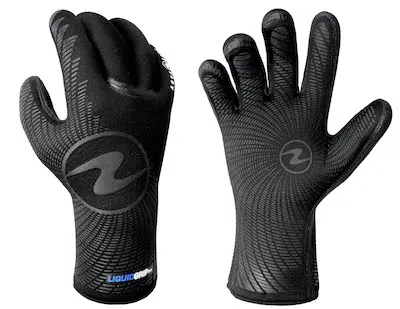Whether we’re scuba diving in cold water or warm water, if we don’t take the right steps to preserve our body temperature it’s possible for any of us to feel cold whilst diving. However, there are many ways to keep warm underwater whilst diving and on our surface intervals – your choice o f exposure equipment will have an impact on you staying warm, as well as how you take care of yourself throughout your diving day, both before and in between dives.
Read on to learn Girls that Scuba’s top tips for keeping warm whilst scuba diving!
The importance of staying warm
The first thing that probably comes to mind when thinking about why we’d want to stay warm is simply our enjoyment of the dive. We’ve all been there; you’re on your second or third scuba dive of the day, trying to be animated about the cool nudibranch your buddy is excitedly pointing out to you, yet all you can think about is getting a warm drink back on land because you’re really feeling the cold.
However, there’s more at stake than simply missing a cool sighting underwater. If you continue to dive when you’re too cold you may put yourself at increased risk of decompression sickness; when you’re cold your blood vessels constrict and blood flows slower, therefore it takes longer than your dive computer might predict for nitrogen to make its way out of your body.
Keeping warm is relevant regardless of whether you’re a cold or warm water diver, however, your tactics for keeping warm may vary. We’ll touch on both in this article, but the most important thing to remember is that temperature difference will have the biggest impact on your ability (or inability) to keep warm. Consider the difference between the air temperature and the water temperature where you’ll be diving, and use that, along with advice from local dive operations, to decide what exposure will be appropriate and how to retain warmth between dives.
Remember that feeling cold can also be subjective and varies hugely from person to person, but don’t be afraid to be the person diving in a thicker exposure suit than everybody else – you’ll be smug and toasty-warm when everyone else on the boat is complaining about the cold!
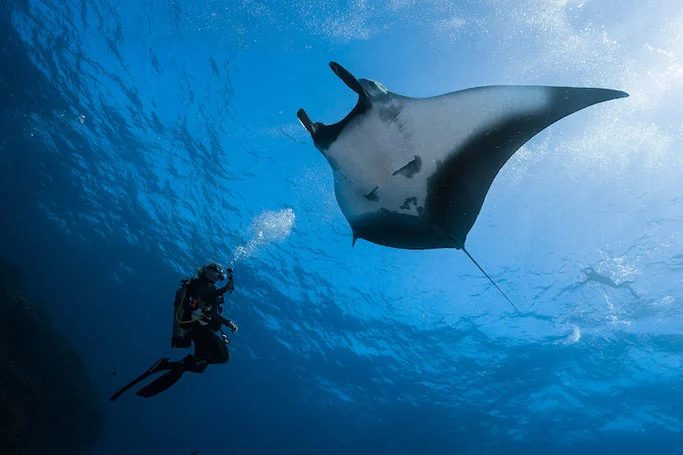
Exposure Suits
As with purchasing any piece of scuba equipment, you need to consider fit, suitability and comfort when deciding what exposure suit to use in order to keep warm. Here’s what to consider with each different type of exposure suit, as well as our rundown of the best undergarments and accessories to consider adding to boost the warmth of your exposure protection!
Wetsuits
Wetsuits can be a fantastic option to keep us warm in a huge variety of temperatures. From 3mm short wetsuits, 5mm full wetsuits, and 7mm options and beyond, you’ll be able to find something which suits your style of diving and keeps you as warm as you need to be. If you find that you feel a bit of a chill in a shortie, remember that overall coverage is just as important as suit thickness; your legs are a large surface area to leave uncovered, meaning more loss of heat.
Regardless of thickness, one thing which all wetsuits have in common is that they won’t keep you warm if they don’t fit correctly. If water is consistently flushing through your suit, particularly in areas such as underarms and lower back, you will have a constant flow of colder water against your skin and it will reduce your overall body temperature during the dive. For this reason, you should always take time to ensure the seals underneath your zips are sitting flat against your skin to prevent water flushing through the wetsuit openings.
A wetsuit should fit snugly, whilst not overly restricting your movement. It’s a difficult balance to strike, however you’ll find it helpful to shop with brands which offer a wide range of sizing options and lengths.



One final thing to consider is that the neoprene which makes up your wetsuit becomes less effective over time. Continually compressing the bubbles inside it at depth means that the suit doesn’t keep its’ warmth as well as it gets older – even though it might still look perfect from the outside! If you’ve purchased a second hand suit, or you’re diving with one which is a few years old and you’re feeling the cold more than you used to, this could be the reason why.
Semi-Drysuits
Semi-drysuits are a great option if you’re feeling you need a bit more warmth beyond a 5mm steamer. They feature more sophisticated seals at the neck, wrists and ankles, and dry zips in order to minimise water movement inside the suit. They also often include thermal properties to reflect heat back to your body.
GTS Loves: Scubapro Nova Scotia 7.5mm Semi-Dry
Drysuits
If you’re consistently diving in cold water, or doing repetitive dives in moderately cold water, learning to dive in a drysuit is without a doubt the best option to keep yourself warm. A drysuit keeps you warm by keeping you dry, precisely as the name suggests! The suit is sealed at the neck, wrists and ankles, and you can customise your body temperature using layers of undergarments beneath the suit.
If you didn’t learn to dive in a drysuit initially, remember that you will need to undertake the correct speciality course to learn to dive dry safely as you have an additional airspace to learn to compensate for whilst underwater.


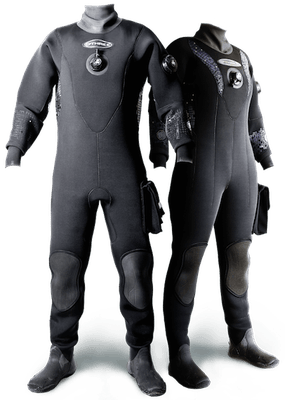
Undergarments
Layers are your best friends when it comes to keeping warm underwater, when diving in both wetsuits and drysuits. Whilst rashguards are often added underneath wetsuits, they don’t necessarily offer any additional warmth. Options such as Sharkskin undergarments are fantastic as they can add significant warmth without adding any additional buoyancy.
Underneath a drysuit, you will want to layer items which have great wicking properties (meaning that they draw any excess moisture away from your skin, allowing your skin to breathe and keeping you warmer), as well as thermal properties. Many divers lean towards layers made from merino wool for these features. The GTS community highly recommends Fourth Element’s Arctic and Xerotherm lines, as well as Bare’s SB Mid Layer options.

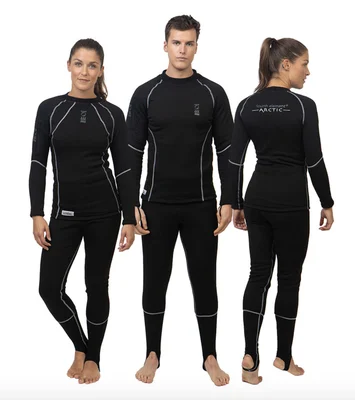
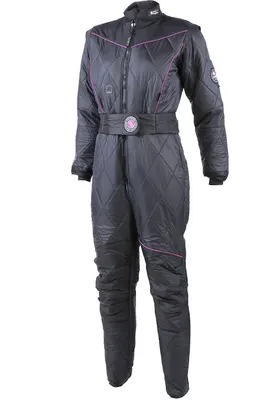
Accessories
It’s not just our bodies that need to stay warm – we lose a huge amount of heat from our hands, feet, and in particular our heads.
Adding a hood or a hooded vest to your exposure suit will help you to retain a huge amount of warmth. These come in a variety of thicknesses, as well as different styles to suit personal preference; some divers find hoods restricting, so try different options of larger and smaller bibs to tuck into your wetsuit, as well as beanie-style neoprene caps if you’re diving in warmer waters.
If the area you’re diving in allows it, consider adding gloves to your exposure suit. Drysuit divers will also want to look at options for dry gloves, such as Fourth Element’s Ellipse system. Layering up on the feet will also help retain warmth and enhance comfort; there are many options for neoprene socks to layer under regular boots or drysuit boots.
Keeping warm out of the water
As we mentioned in the beginning of this article, how we take care of ourselves before and in between our dives will have a huge impact on our ability to stay nice and warm underwater and throughout the day. Take these tips on board to stay toasty throughout a full day’s diving.
Stay fed and watered
We all know that we should be staying hydrated in order to lower our chances of getting decompression sickness, but did you also know that being dehydrated impacts your body’s ability to keep warm? Dehydration can cause your core temperature to drop, which is the biggest problem when doing repetitive dives across multiple days. Hot drinks or even soups can be a great option to warm yourself up between dives, but avoid excessive caffeine intake.
Your body requires a lot of energy to keep you warm, so ensure you’re fuelling up with healthy, balanced meals throughout the day. The way that liveaboards generally structure their days is a great example of this; there are often small meals and snacks offered in between every dive in order to keep energy levels consistent.
Dry off between dives
If your surface interval length and boat size allow, try and remove your exposure suit in between dives and fully dry yourself. This will be more applicable when diving from larger day boats or liveaboards as opposed to small ribs, and perhaps more relevant to wetsuits than drysuits.
Microfibre towels are great for drying yourself off quickly and efficiently, and designs such as the Dryrobe turn this into a wearable layer for warmth between dives, as well as somewhere to discretely get changed. Consider having multiple bikinis, swimsuits, and even rash vests to be able to change your base-layer so that it’s not quite so cold getting back into a damp wetsuit for your next dive.
Wind chill can also have a huge impact; if you’ll be diving somewhere windy, the Fourth Element Storm Poncho can protect you, and can be worn over just baselayers or over your whole exposure suit if you don’t have time to remove it.
When diving in warm places an air temperature which may usually be bearable or even hot can start to feel cooler after repetitive dives, so have a hoodie and perhaps even a beanie on hand to keep your core temperature up on your surface interval. Bonus points if it’s a GTS beanie!


What are your top tips for keeping warm whilst scuba diving? Let us know in the comments below, join the discussion in our Facebook group, or share with us on Instagram @girlsthatscuba!

About the author – our GTS blogger Lauren
Lauren originally learned to dive in 2008, and her heart has been in the ocean ever since. In 2018 her sense of adventure and passion for the underwater world led her to Indonesia, where she completed her PADI Divemaster and Instructor qualifications. You can find her on Instagram @laurennn_elizabeth to follow where the currents take her next!

